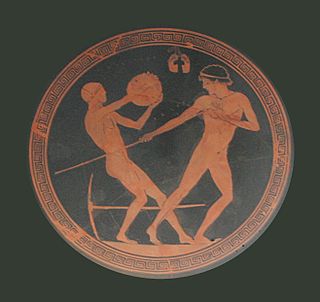
The 1896 Summer Olympics, officially known as the Games of the I Olympiad, was the first international Olympic Games held in modern history. Organised by the International Olympic Committee (IOC), which had been created by Pierre de Coubertin, it was held in Athens, Greece, from 6 to 15 April 1896.

The modern pentathlon is an Olympic sport that comprises five different events; fencing, freestyle swimming (200 m), equestrian show jumping, and a final combined event of pistol shooting and cross country running (3200 m). This last event is now referred to as the laser-run, since it alternates four legs of laser pistol shooting followed by an 800 m run. The event is inspired by the traditional pentathlon held during the ancient Olympics; as the original events were patterned on the skills needed by an ideal Greek soldier of the era, the modern pentathlon is similarly patterned on events representing the skills needed by cavalry behind enemy lines.

A pentathlon is a contest featuring five events. The name is derived from Greek: combining the words pente (five) and -athlon (competition). The first pentathlon was documented in Ancient Greece and was part of the Ancient Olympic Games. Five events were contested over one day for the Ancient Olympic pentathlon, starting with the long jump, javelin throwing, and discus throwing, followed by the stadion and wrestling. Pentathletes were considered to be among the most skilled athletes, and their training was often part of military service—each of the five events in the pentathlon was thought to be useful in war or battle.
Holger Louis Nielsen was a Danish fencer, shooter, and athlete. He competed at the 1896 Summer Olympics in Athens. He is probably best known for drawing up the first modern set of rules for the game of handball.

Pantelis Karasevdas was a Greek shooter. He was a member of Panachaikos Gymnastikos Syllogos, that merged in 1923 with Gymnastiki Etaireia Patron to become Panachaiki Gymnastiki Enosi. Karasevdas competed at the 1896 Summer Olympics in Athens, where he won a gold medal for the host country.

Anastasios Metaxas was a Greek architect and shooter.

Georgios Orphanidis was a Greek sports shooter. He competed at the 1896 Summer Olympics in Athens and at the 1908 Summer Olympics in London. He also competed at the 1906 Intercalated Games.

Three athletes from Denmark competed in five sports at the 1896 Summer Olympics in Athens. Two of the three combined to win a gold medal, two silvers, and three bronzes, while Eugen Schmidt earned no medals. Viggo Jensen contributed one of each color, while Holger Nielsen earned the second silver and two bronzes. Shooting and weightlifting were Denmark's most successful sports. Denmark had 15 entries in 12 events, winning six medals.

Thirteen athletes from France competed in six sports at the 1896 Summer Olympics. France won the fourth-most gold medals with 5 and the fourth-most total medals with 11. Cycling was the sport in which the French competitors had the most success, as they completely dominated the field. The French team had 27 entries in 18 events, winning 11 medals.

Greece was the host nation of the 1896 Summer Olympics held in Athens. The number of Greek contestants is commonly cited as 169, but as many as 176 Greeks contested events in all nine sports. The Greeks were by far the most successful nation in terms of total medals with 46, 26 more than the United States of America. Nevertheless, their number of first-place finishes (10) was one fewer than the Americans' 11. The Greeks had 172 entries in 39 events. Only 4 events had no Greek entrants—the 400 metres and the high jump in athletics and the vault and the team horizontal bar in gymnastics.

Fourteen competitors from the United States competed in three sports at the 1896 Summer Olympics in Athens, Greece. The Americans were the most successful athletes in terms of gold medals, beating host nation Greece, 11 to 10, despite fielding only 14 competitors compared to an estimated 169 Greek entrants. However, the Greeks' 46 total medals dwarfed the Americans' 20.
John Bryant Paine was an American shooter. He competed at the 1896 Summer Olympics in Athens.
Sumner Paine was an American shooter. He competed at the 1896 Summer Olympics in Athens.

The men's high jump was one of four jumping events on the Athletics at the 1896 Summer Olympics programme. The high jump was held on 10 April. Five competitors from three nations took part in the event. Ellery Clark, who had previously won the long jump, also won this event. Garrett and Connolly tied for second place.

The men's vault was one of the eight gymnastics events on the Gymnastics at the 1896 Summer Olympics programme. The third event, it was held on 9 April. 15 athletes from five nations competed. The Germans captured the gold and bronze medals, while Zutter won the silver for Switzerland.

The men's 200 metre military rifle event was one of five sport shooting events on the Shooting at the 1896 Summer Olympics programme. It was held at a distance of 200 metres, on 8 April and 9 April, with each shooter firing half of his shots on the first day and half the second. Shooters fired four strings of ten shots each, for a total of 40 shots. 42 shooters, representing each of the seven nations that had shooters in Athens, competed.

The men's 300 m rifle three positions was one of the five sport shooting events on the Shooting at the 1896 Summer Olympics programme. The second rifle event and last of the shooting events, the free rifle was begun on 11 April. Each marksman fired 40 shots, in four strings of ten. 25 men entered the event, though only 20 actually competed. They represented three nations. Frangoudis led after the first day, but when the event was continued on 12 April, Orphanidis took the lead and held on to win first place. He hit the target 37 times.

The 25 metre muzzle-loading pistol was one of the five sport shooting events on the 1896 Summer Olympics shooting programme. The armament of the American Paine brothers was disqualified because of not being "of the usual calibre" for the event. With the Paine brothers declining the offer of the Greek shooters to use their pistols, only four shooters entered the fourth shooting event. Three nations were represented. Each shooter fired five strings of six shots at a target 25 metres distant. The competition was held on 11 April and resulted in the top two places going to the Greek marksmen. Nielsen took third place and Merlin did not finish.
The men's 30 metre individual competition with free revolver was one of the five sport shooting events on the 1896 Summer Olympics shooting program. Six competitors entered the pistol event on 11 April. Having won the 25 metre military pistol event, John Paine then withdrew from the 30 metre free pistol event, citing his desire to not embarrass his Greek hosts. He also said he had an agreement with his brother that whoever won the first event between them would drop out the next event. The competitors each shot five strings of six shots. Sumner Paine won the event.

The men's ISSF 25 meter rapid fire pistol was a shooting sports event held as part of the Shooting at the 1924 Summer Olympics programme. It was the fourth appearance of the event. The competition was held on 28 June 1924 at the shooting ranges at Versailles. 55 shooters from 17 nations competed. Nations were limited to four shooters each. Henry Bailey won the United States' second consecutive championship in the event. Sweden also earned the same medal as in 1912, with Vilhelm Carlberg's silver. Lennart Hannelius took bronze in Finland's debut in the event.















